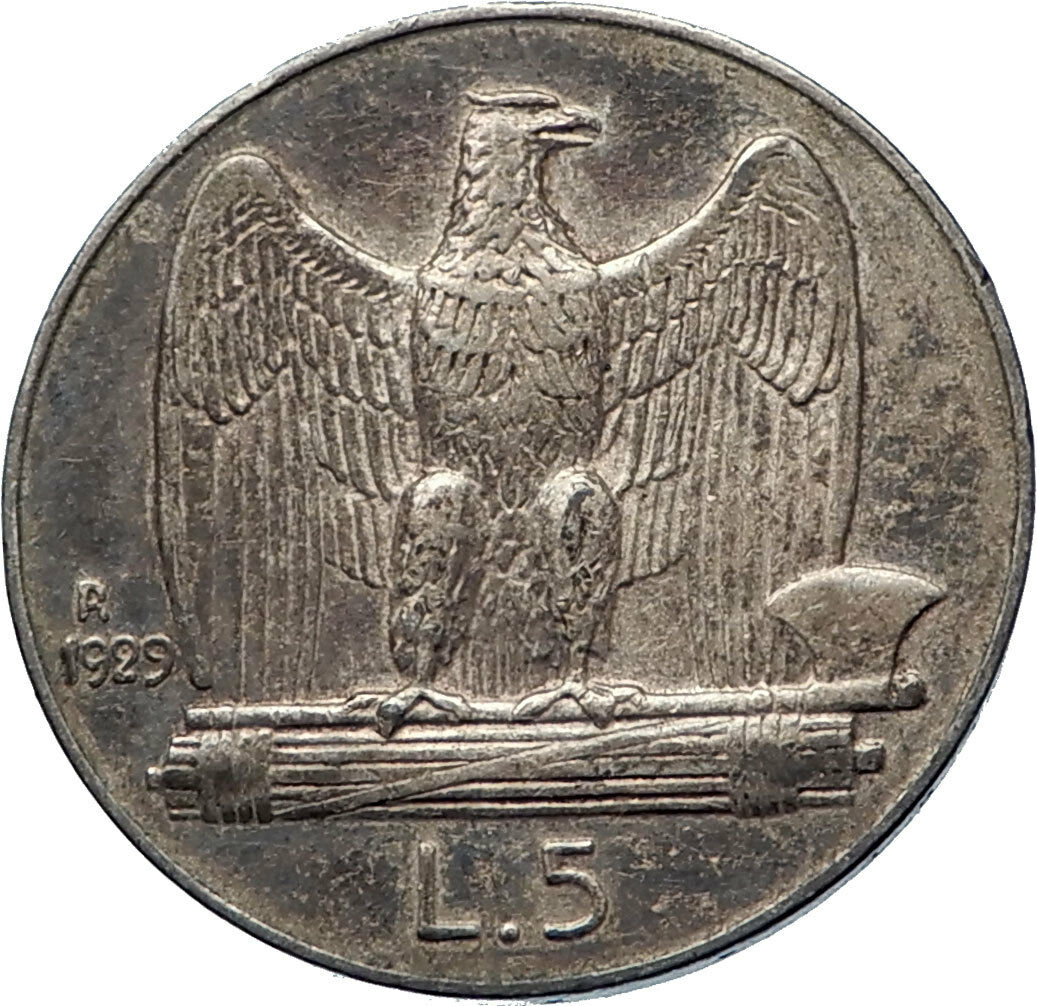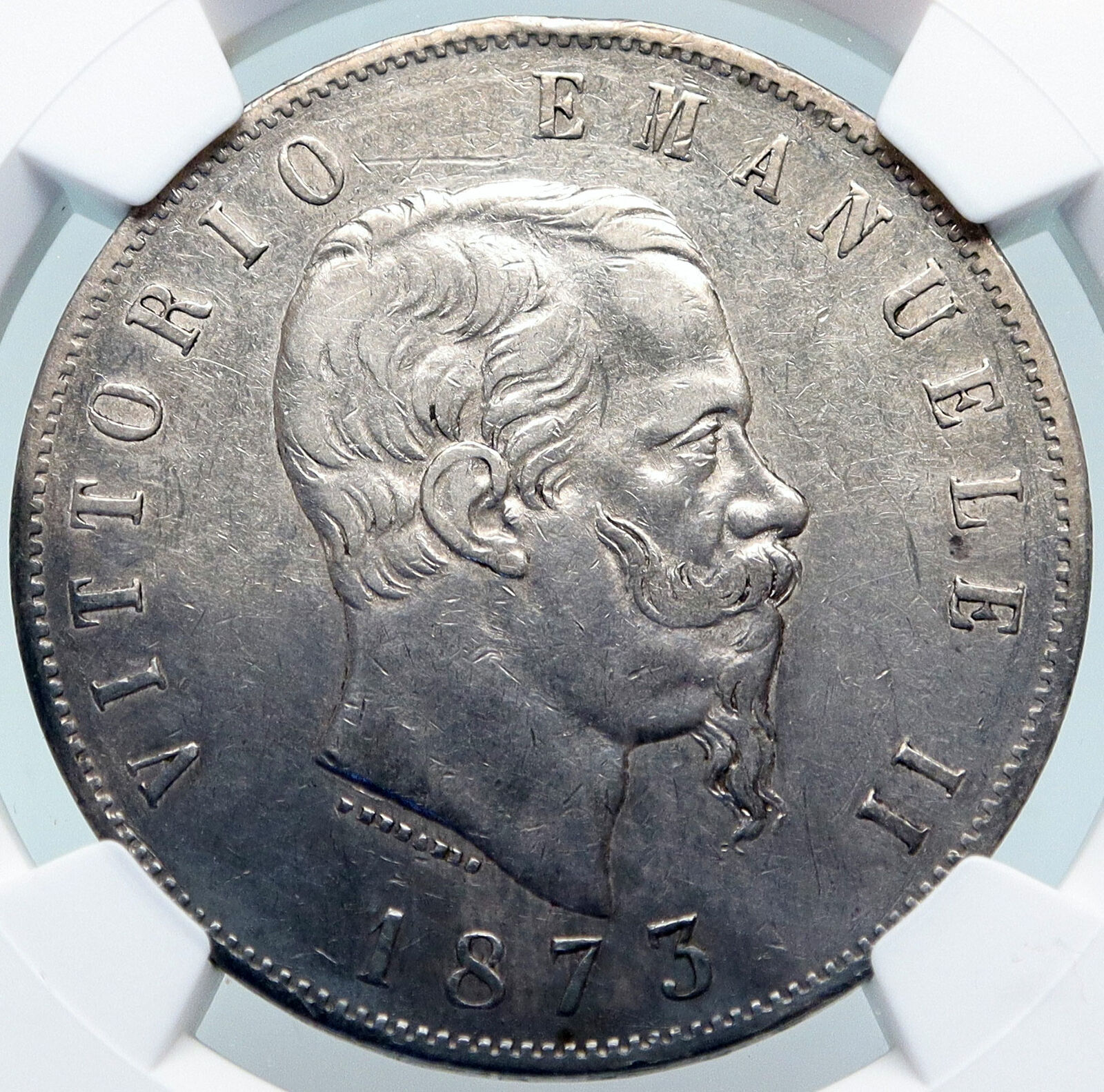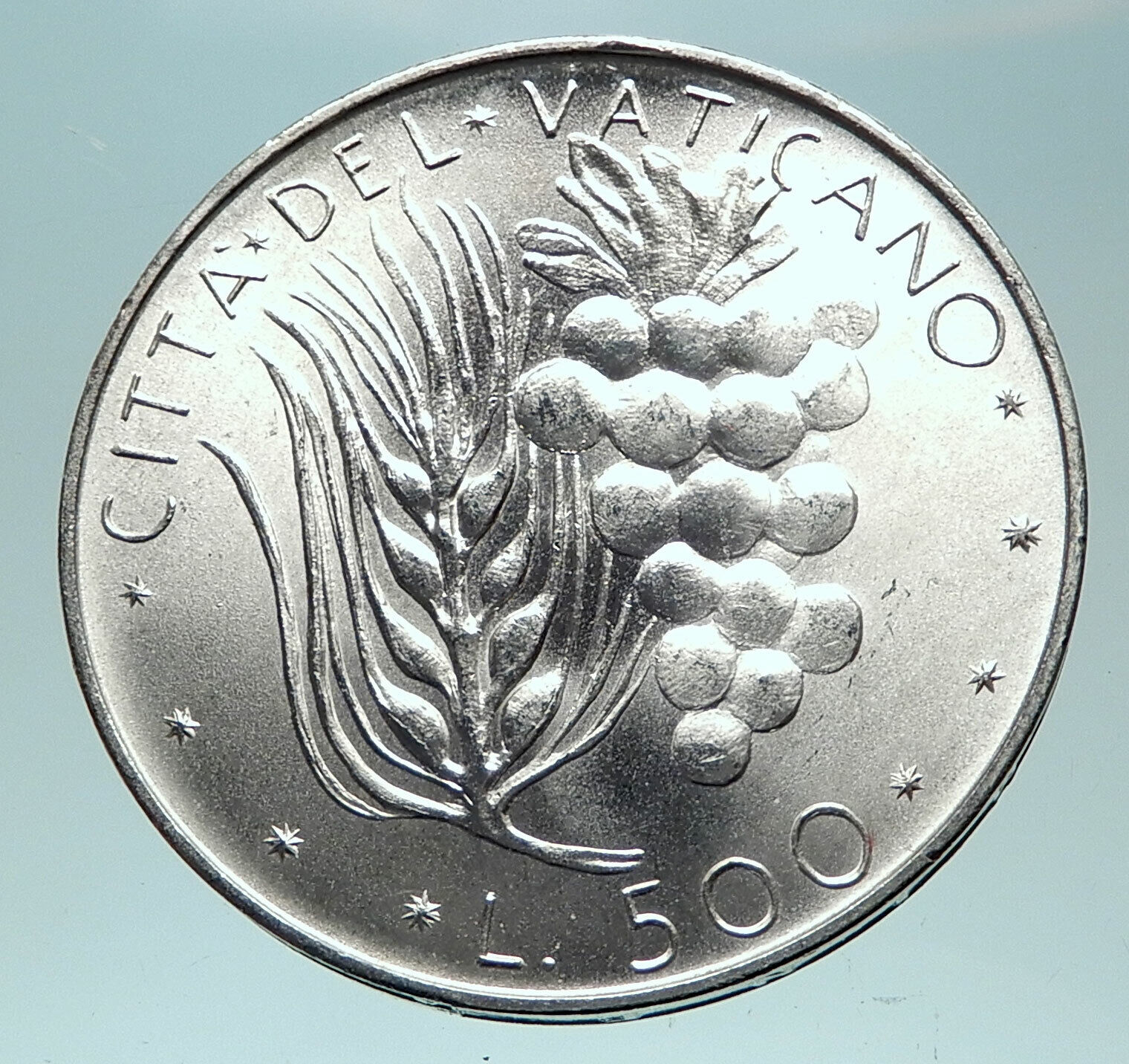|
Italy under Victor Emmanuel II – King: 17 March 1861 – 9 January 1878
1863 M BN Silver 1 Lira 23.1mm (4.70 grams) 0.835 Silver (0.1235 oz. ASW)
Reference: KM# 5a
VITTORIO EMANUELE II FERRARIS, King Vittorio Emanuele II facing right.
REGNO D’ITALIA 1 LIRA M BN, Savoia coat of arms decorated with the Collare dell’Annunziata, both within a laurel wreath.
Edge Lettering:
“FERT FERT FERT” inscription with Guilloche and rosettes
You are bidding on the exact item pictured, provided with a Certificate of Authenticity and Lifetime Guarantee of Authenticity.
 Victor Emmanuel II (Italian: Vittorio Emanuele II; full name: Vittorio Emanuele Maria Alberto Eugenio Ferdinando Tommaso di Savoia; 14 March 1820 – 9 January 1878) was King of Sardinia from 1849 until 17 March 1861. At that point, he assumed the title of King of Italy and became the first king of a united Italy since the 6th century, a title he held until his death in 1878. The Italians gave him the epithet of Father of the Fatherland (Italian: Padre della Patria). The monument Altare della Patria (or Vittoriano) in Rome was built in his honor. Victor Emmanuel II (Italian: Vittorio Emanuele II; full name: Vittorio Emanuele Maria Alberto Eugenio Ferdinando Tommaso di Savoia; 14 March 1820 – 9 January 1878) was King of Sardinia from 1849 until 17 March 1861. At that point, he assumed the title of King of Italy and became the first king of a united Italy since the 6th century, a title he held until his death in 1878. The Italians gave him the epithet of Father of the Fatherland (Italian: Padre della Patria). The monument Altare della Patria (or Vittoriano) in Rome was built in his honor.
Victor Emmanuel was born as the eldest son of Charles Albert, Prince of Carignano, and Maria Theresa of Austria. His father succeeded a distant cousin as King of Sardinia-Piedmont in 1831. He lived for some years of his youth in Florence and showed an early interest in politics, the military, and sports. In 1842, he married his cousin, Adelaide of Austria. He was styled as the Duke of Savoy prior to becoming King of Sardinia-Piedmont.
He took part in the First Italian War of Independence (1848-1849) under his father, King Charles Albert, fighting in the front line at the battles of Pastrengo, Santa Lucia, Goito and Custoza.
He became King of Sardinia-Piedmont in 1849 when his father abdicated the throne, after a humiliating military defeat by the Austrians at the Battle of Novara. Victor Emmanuel was immediately able to obtain a rather favorable armistice at Vignale by the Austrian imperial army commander, Radetzky. The treaty, however, was not ratified by the Piedmontese lower parliamentary house, the Chamber of Deputies, and Victor Emmanuel retaliated by firing his Prime Minister, Claudio Gabriele de Launay, replacing him with Massimo D’Azeglio. After new elections, the peace with Austria was accepted by the new Chamber of Deputies. In 1849, Victor Emmanuel also fiercely suppressed a revolt in Genoa, defining the rebels as a “vile and infected race of canailles.”
In 1852, he appointed Count Camillo Benso of Cavour (“Count Cavour”) as Prime Minister of Piedmont-Sardinia. This turned out to be a wise choice, since Cavour was a political mastermind and a major player in the Italian unification in his own right. Victor Emmanuel II soon became the symbol of the “Risorgimento”, the Italian unification movement of the 1850s and early 60s. He was especially popular in the Kingdom of Sardinia-Piedmont because of his respect for the new constitution and his liberal reforms.
 ![Location of Italy (dark green)– in Europe (light green & dark grey)– in the European Union (light green) – [Legend]](https://upload.wikimedia.org/wikipedia/commons/thumb/b/ba/EU-Italy.svg/250px-EU-Italy.svg.png) Italyly, officially the Italian Republic (Italian: Repubblica Italiana), is a unitary parliamentary republic in Europe. Italy covers an area of 301,338 km2 (116,347 sq mi) and has a largely temperate climatelo Stivale (the Boot). With 61 million inhabitants, it is the 4th most populous EU member state. Located in the heart of the e Mediterranean Sea, Italy shares open land borders with France, Switzerland, Austria, Slovenia, San Marino and Vatican City. Italyly, officially the Italian Republic (Italian: Repubblica Italiana), is a unitary parliamentary republic in Europe. Italy covers an area of 301,338 km2 (116,347 sq mi) and has a largely temperate climatelo Stivale (the Boot). With 61 million inhabitants, it is the 4th most populous EU member state. Located in the heart of the e Mediterranean Sea, Italy shares open land borders with France, Switzerland, Austria, Slovenia, San Marino and Vatican City.
 Since ancient times, Greek, Etruscan, Celtic, and other cultures have thrived on the Italian Peninsula. Rome ultimately emerged as the dominant power, conquering much of the ancient world and becoming the leading cultural, political, and religious centreWestern civilisation. During the Dark Ages, the region suffered sociopolitical collapse amid calamitous barbarian invasions, but by the 11th century, numerous Italian city-states rose to great prosperity through shipping, commerce and banking, and even laid the groundwork for capitalism. The Renaissance led to a flourishing of Italian culture, producing famous scholars, artists, and polymaths such as Leonardo da Vinci, Galileo, Michelangelo and Machiavelli. Italian explorers such as Marco Polo, Christopher Columbus, Amerigo Vespucci, and Giovanni da Verrazzano discovered new routes to the Far Eastst and the New World, helping to usher in the European Age of Discovery. Nevertheless, Italy remained politically fragmented and fell prey to European powers such as France, Spain, and later Austria, subsequently entering a long period of decline that lasted until the mid-19th century. Since ancient times, Greek, Etruscan, Celtic, and other cultures have thrived on the Italian Peninsula. Rome ultimately emerged as the dominant power, conquering much of the ancient world and becoming the leading cultural, political, and religious centreWestern civilisation. During the Dark Ages, the region suffered sociopolitical collapse amid calamitous barbarian invasions, but by the 11th century, numerous Italian city-states rose to great prosperity through shipping, commerce and banking, and even laid the groundwork for capitalism. The Renaissance led to a flourishing of Italian culture, producing famous scholars, artists, and polymaths such as Leonardo da Vinci, Galileo, Michelangelo and Machiavelli. Italian explorers such as Marco Polo, Christopher Columbus, Amerigo Vespucci, and Giovanni da Verrazzano discovered new routes to the Far Eastst and the New World, helping to usher in the European Age of Discovery. Nevertheless, Italy remained politically fragmented and fell prey to European powers such as France, Spain, and later Austria, subsequently entering a long period of decline that lasted until the mid-19th century.
After various unsuccessful attempts, the second and the third wars for Italian independence resulted in the eventual unification of most of present-day Italy by 1866. From the late 19th century to the early 20th century, the new Kingdom of Italycolonial empire, becoming a great power. However, southern and rural areas of the country remained largely excluded from industrialisation, fuelling a large and influential diaspora. Despite being one of the main victorsrs in World War I, Italy entered a period of economic crisis and social turmoil, leading the way to the rise of a Fascist dictatorship in 1922. The subsequent participation in World War II on the Axis side ended in military defeat, economic destruction and civil war. In the years that followed, Italy abolished the monarchy, reinstated democracy, and enjoyed a prolonged economic boom, thus becoming one of the world’s most developed nations.
Italy has the third largest economy in the Eurozone and the eighth largest economy in the world. It has a very high level of human development and enjoys the highest life expectancy in the EU. Italy plays a prominent role in global military, cultural and diplomatic affairs and is also considered to be a major regional power in Europe. Italy is a founding and leading member of the European Union and the member of numerous international institutions, including the UN, NATO, the OECD, the OSCE, the WTO, the G7/G8, G20, the Union for the Mediterranean, the Council of Europe, Uniting for Consensus, and many more. As a reflection of its vast cultural wealth, Italy is home to 51 World Heritage Sites, the most in the world, and is one of the most visited countries.
|





 Victor Emmanuel II (Italian: Vittorio Emanuele II; full name: Vittorio Emanuele Maria Alberto Eugenio Ferdinando Tommaso di Savoia; 14 March 1820 – 9 January 1878) was King of Sardinia from 1849 until 17 March 1861. At that point, he assumed the title of King of Italy and became the first king of a united Italy since the 6th century, a title he held until his death in 1878. The Italians gave him the epithet of Father of the Fatherland (Italian: Padre della Patria). The monument Altare della Patria (or Vittoriano) in Rome was built in his honor.
Victor Emmanuel II (Italian: Vittorio Emanuele II; full name: Vittorio Emanuele Maria Alberto Eugenio Ferdinando Tommaso di Savoia; 14 March 1820 – 9 January 1878) was King of Sardinia from 1849 until 17 March 1861. At that point, he assumed the title of King of Italy and became the first king of a united Italy since the 6th century, a title he held until his death in 1878. The Italians gave him the epithet of Father of the Fatherland (Italian: Padre della Patria). The monument Altare della Patria (or Vittoriano) in Rome was built in his honor. 
![Location of Italy (dark green)– in Europe (light green & dark grey)– in the European Union (light green) – [Legend]](https://upload.wikimedia.org/wikipedia/commons/thumb/b/ba/EU-Italy.svg/250px-EU-Italy.svg.png) Italyly, officially the Italian Republic (Italian:
Italyly, officially the Italian Republic (Italian:  Since ancient times, Greek, Etruscan, Celtic, and other cultures have thrived on the Italian Peninsula. Rome ultimately emerged as the dominant power, conquering much of the ancient world and becoming the leading cultural, political, and religious centreWestern civilisation. During the Dark Ages, the region suffered sociopolitical collapse amid calamitous barbarian invasions, but by the 11th century, numerous Italian city-states rose to great prosperity through shipping, commerce and banking, and even laid the groundwork for capitalism. The Renaissance led to a flourishing of Italian culture, producing famous scholars, artists, and polymaths such as Leonardo da Vinci, Galileo, Michelangelo and Machiavelli. Italian explorers such as Marco Polo, Christopher Columbus, Amerigo Vespucci, and Giovanni da Verrazzano discovered new routes to the Far Eastst and the New World, helping to usher in the European Age of Discovery. Nevertheless, Italy remained politically fragmented and fell prey to European powers such as France, Spain, and later Austria, subsequently entering a long period of decline that lasted until the mid-19th century.
Since ancient times, Greek, Etruscan, Celtic, and other cultures have thrived on the Italian Peninsula. Rome ultimately emerged as the dominant power, conquering much of the ancient world and becoming the leading cultural, political, and religious centreWestern civilisation. During the Dark Ages, the region suffered sociopolitical collapse amid calamitous barbarian invasions, but by the 11th century, numerous Italian city-states rose to great prosperity through shipping, commerce and banking, and even laid the groundwork for capitalism. The Renaissance led to a flourishing of Italian culture, producing famous scholars, artists, and polymaths such as Leonardo da Vinci, Galileo, Michelangelo and Machiavelli. Italian explorers such as Marco Polo, Christopher Columbus, Amerigo Vespucci, and Giovanni da Verrazzano discovered new routes to the Far Eastst and the New World, helping to usher in the European Age of Discovery. Nevertheless, Italy remained politically fragmented and fell prey to European powers such as France, Spain, and later Austria, subsequently entering a long period of decline that lasted until the mid-19th century.




